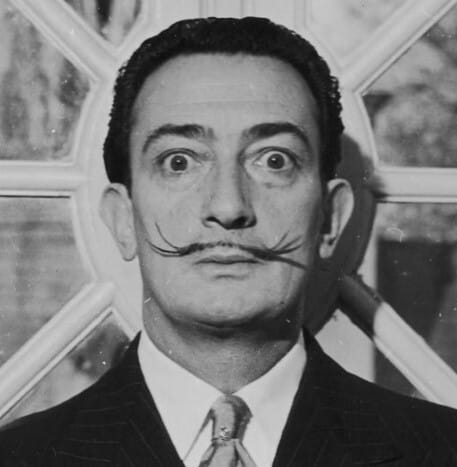
I wonder if the grass is still in the box. (You’ll see.) — Dan
The $10,000 Blade of Grass

Pictured above is Salvador Dalí, the famous Spanish surrealist. He’s most well-known for his 1931 masterpiece The Persistence of Memory — you know, the one with the melted clocks — which he painted in his late 20s. It sold for $250 the next year (that’s a present-day equivalent of about $5,500) and was donated to New York’s Museum of Modern Art two years later. Dalí was well-known in the art world early in his life, and his fame spread well beyond that sphere. Everything he made was highly sought after by fans far and wide.
Including his mustache.
As seen above, Dalí’s facial hair was distinctive. And that wasn’t by mistake. Dalí started donning a mustache in the 1920s but it was a basic one at that time; over the decades, it became increasingly pronounced. In 1955, Dalí sat down for an interview with the BBC about his art, but it somehow became a conversation about the ‘stache; as the broadcaster would later share, the interviewer, Malcolm Muggeridge, asked “for more details on his gravity-defying facial hair” and found out a lot, including that “the artist cleaned it every evening – allowing it to become soft and droop down overnight – the time it took to get ready in the morning – a brisk three minutes,” and more. The mustache was something fans and the public, generally, cared a lot about. Including, perhaps most notably, Yoko Ono.
Ono, the Japanese singer-songwriter, had a “naïve obsession with his [Dalí’s] surrealism,” according to Far Out Magazine, and came up with a great way to own a unique piece of Dalí’s work. According to Amanda Lear, a French actress widely seen as Dalí’s' muse for the last 20 years of his life, Ono wanted to buy a strand of hair from Dalí’s mustache. Lear, per the Telegraph, would later say that Dalí “could never resist the lure of a check.” And Ono was offering a large one — $10,000, or the equivalent of five to ten times that in today’s dollars.
But while Dalí was happy to take Ono’s money, he wasn’t so keen on sending her anything so intimate. According to ArtNet, “he worried Ono was a witch and thought that she might use it for occult purposes.” As Lear would later tell French magazine VSD (via ArtNet), “He didn’t want to send her a personal item, much less one of his hairs. So he sent me to the garden to find a dry blade of grass, and sent it off in a pretty box.” It was exactly the kind of stunt you’d expect from Dalí, who thrived on blurring the line between art, myth, and mischief.
Ono apparently never was the wiser. And even if she did? Maybe she’d be okay with it. What’s more surreal than getting a counterfeit piece of mustache hair from Salvador Dalí?
Visit Today’s Sponsor!
How 15 Small Brands Achieved Remarkable Marketing Results
Stop believing you need a big budget to make an impact. Our latest collection highlights 15 small brands that transformed limited resources into significant market disruption through innovative thinking.
Case studies revealing ingenious approaches to common marketing challenges
Practical tactics that delivered 900%+ ROI with minimal investment
Strategic frameworks for amplifying your brand without amplifying your budget
These actionable insights can be implemented immediately, regardless of your team or budget size. See how small brands are making big waves in today's market.
More About Dalí
Today’s Bonus fact: If you want an original Dalí in your room, be prepared to pay a lot for it — or $5, if you’re lucky, and a student at Oberlin College in Ohio. In 1940, as HuffPost reported, art professor Ellen Johnson “founded the Art Rental program at the Allen Memorial Art Museum, which allows (and trusts) students to rent authentic works at an affordable $5 per semester. Each year, hundreds of pieces by artists such as Pablo Picasso, Roy Lichtenstein and Salvador Dalí, among others, go on temporary display in student housing.” Students used to line up overnight — the program was first-come, first-served — but now, it’s a lottery. And to date, none of the loaned works have been significantly damaged.
From the Archives: Let’s Call it a Draw: Check out the Bonus Fact.
Support Now I Know!
Now I Know is supported by readers like you. Yes, you! Many of my readers donate a few dollars a month to help Now I Know grow and thrive. And in exchange, they get an ad-free version!
Interested in supporting Now I Know? Click here!
And thanks! — Dan


